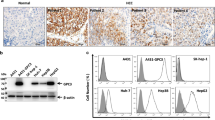Abstract
We present a detailed method for constructing a mammalian cell-based full-length antibody display library for targeting hepatocellular carcinoma. Two novel mammalian library vectors pcDNA3-CHm and pcDNA3-CLm were constructed that contained restriction enzyme sites NheI, ClaI and antibody constant domain. Mammalian expression vector pcDNA3-CHm contains IgG heavy-chain (HC) constant region and glycosylphosphatidylinositol anchor (GPI) that could be anchored full-length antibodies on the surface of mammalian cells. GOLPH2 prokaryotic expression vector was carried out in Escherichia coli and purified by immobilized metal affinity chromatography. Variable domain of heavy-chain and variable domain of light-chain genes were respectively inserted into the vector pcDNA3-CHm and pcDNA3-CLm by ligation, and antibody libraries are displayed as whole IgG molecules on the cell surface by co-transfecting this HC-GPI with a light chain. By screening the cell library using magnetic beads and cell ELISA, the cell clone that displayed GOLPH2-specific antibodies on cell surfaces was identified. The mammalian cell-based antibody display library is a great potential application for displaying full-length functional antibodies of targeting hepatocellular carcinoma on the surface of mammalian cells. Anti-GOLPH2 display antibody was successfully isolated from the library.





Similar content being viewed by others
References
Aires DSF, Corte-Real S, Goncalves J (2008) Recombinant antibodies as therapeutic agents: pathways for modeling new biodrugs. BioDrugs 22:301–314. doi:10.2165/00063030-200822050-00003
Akamatsu Y, Pakabunto K, Xu Z, Zhang Y, Tsurushita N (2007) Whole IgG surface display on mammalian cells: application to isolation of neutralizing chicken monoclonal anti-IL-12 antibodies. J Immunol Methods 327:40–52. doi:10.1016/j.jim.2007.07.007
Beerli RR, Bauer M, Buser RB, Gwerder M, Muntwiler S, Maurer P, Saudan P (2008) Isolation of human monoclonal antibodies by mammalian cell display. Proc Natl Acad Sci USA 105:14336–14341. doi:10.1073/pnas.0805942105
Block TM, Marrero J, Gish RG, Sherman M, London WT, Srivastava S, Wagner PD (2008) The degree of readiness of selected biomarkers for the early detection of hepatocellular carcinoma: notes from a recent workshop. Cancer Biomark 4(1):19–33
Bruix J, Sherman M (2011) Management of hepatocellular carcinoma: an update. Hepatology 53(3):1020–1022. doi:10.1002/hep. 24199
El-Serag HB, Rudolph KL (2007) Hepatocellular carcinoma: epidemiology and molecular carcinogenesis. Gastroenterology 132:2557–2576. doi:10.1053/j.gastro.2007.04.061
Farazi PA, DePinho RA (2006) Hepatocellular carcinoma pathogenesis: from genes to environment. Nat Rev Cancer 6:674–687. doi:10.1038/nrc1934
Fitting J, Killian D, Junghanss C, Willenbrock S, Murua Escobar H, Lange S, Nolte I, Barth S, Tur MK (2011) Generation of recombinant antibody fragments that target canine dendritic cells by phage display technology. Vet Comp Oncol 9:183–195. doi:10.1111/j.1476-5829.2010.00246.x
Gu Y, Chen W, Zhao Y, Chen L, Peng T (2009) Quantitative analysis of elevated serum Golgi protein-73 expression in patients with liver diseases. Ann Clin Biochem 46:38–43. doi:10.1258/acb.2008.008088
Huang SF, Liu DB, Zeng JM, Xiao Q, Luo M, Zhang WP, Tao K, Wen JP, Huang ZG, Feng WL (2009) Cloning, expression, purification and functional characterization of the oligomerization domain of Bcr-Abl oncoprotein fused to the cytoplasmic transduction peptide. Protein Expr Purif 64:167–178. doi:10.1016/j.pep. 2008.10.023
Leong MK, Chen C, Shar KC, Shiuan D (2007) Selection and characterization of lipase abzyme from phage displayed antibody libraries. Biochem Biophys Res Commun 361:567–573. doi:10.1016/j.bbrc.2007.07.07112
Loo L, Robinson MK, Adams GP (2008) Antibody engineering principles and applications. Cancer J 14(3):149–153. doi:10.1097/PPO.0b013e318173a5d5
Luk JM, Wong KF (2006) Monoclonal antibodies as targeting and therapeutic agents: prospects for liver transplantation, hepatitis and hepatocellular carcinoma. Clin Exp Pharmacol Physiol 33:482–488. doi:10.1111/j.1440-1681.2006.04396.x
Mao Y, Yang H, Xu H, Lu X, Sang X, Du S, Zhao H, Chen W, Xu Y, Chi T, Yang Z, Cai J, Li H, Chen J, Zhong S, Mohanti SR, Lopez-Soler R, Millis JM, Huang J, Zhang H (2010) Golgi protein 73 (GOLPH2) is a valuable serum marker for hepatocellular carcinoma. Gut 59:1687–1693. doi:10.1136/gut.2010.214916
Mazor Y, Van Blarcom T, Iverson BL, Georgiou G (2008) E-clonal antibodies: selection of full-length IgG antibodies using bacterial periplasmic display. Nat Protoc 3:1766–1777. doi:10.1038/nprot.2008.176
Riener MO, Stenner F, Liewen H, Soll C, Breitenstein S, Pestalozzi BC, Samaras P, Probst-Hensch N, Hellerbrand C, Müllhaupt B, Clavien PA, Bahra M, Neuhaus P, Wild P, Fritzsche F, Moch H, Jochum W, Kristiansen G (2009) Golgi phosphoprotein 2 (GOLPH2) expression in liver tumors and its value as a serum marker in hepatocellular carcinomas. Hepatology 49:1602–1609. doi:10.1002/hep. 22843
Roobol MJ, Haese A, Bjartell A (2011) Tumour markers in prostate cancer III: biomarkers in urine. Acta Oncol 50:85–89. doi:10.3109/0284186X.2010.524935
Rothe A, Hosse RJ, Power BE (2006) Ribosome display for improved biotherapeutic molecules. Expert Opin Biol Ther 6:177–187. doi:10.1517/14712598.6.2.177
Rudnick SI, Adams GP (2009) Affinity and avidity in antibody-based tumor targeting. Cancer Biother Radiopharm 24(2):155–161. doi:10.1089/cbr.2009.0627
Ye SL, Takayama T, Geschwind J, Marrero JA, Bronowicki JP (2010) Current approaches to the treatment of early hepatocellular carcinoma. Oncologist 15:34–41. doi:10.1634/theoncologist.2010-S4-34
Zhou C, Jacobsen FW, Cai L, Chen Q, Shen WD (2010a) Development of a novel mammalian cell surface antibody display platform. MABS 2:508–518. doi:10.4161/mabs.2.5.12970
Zhou Y, Chen ZR, Li CZ, He W, Liu S, Jiang S (2010b) A novel strategy for rapid construction of libraries of full-length antibodies highly expressed on mammalian cell surfaces. Acta Biochim Biophys Sin 42:575–584. doi:10.1093/abbs/gmq055
Acknowledgments
We thank Prof. Guo Yajun, International Joint Cancer Institute, The Second Military Medical University, for supplying vector pcDNA3-CH and pcDNA3-CL.
Author information
Authors and Affiliations
Corresponding author
Additional information
This study was supported by the National Key Basic Research Program (973 Program) funded project (2010CB833605), People’s Republic of China.
Rights and permissions
About this article
Cite this article
Li, F., Liu, YH., Li, YW. et al. Construction and development of a mammalian cell-based full-length antibody display library for targeting hepatocellular carcinoma. Appl Microbiol Biotechnol 96, 1233–1241 (2012). https://doi.org/10.1007/s00253-012-4243-5
Received:
Revised:
Accepted:
Published:
Issue Date:
DOI: https://doi.org/10.1007/s00253-012-4243-5




